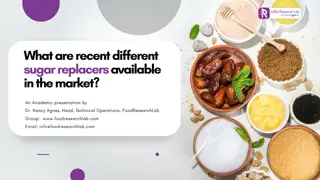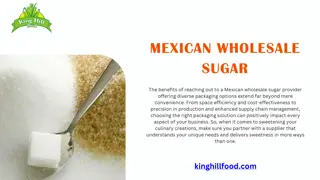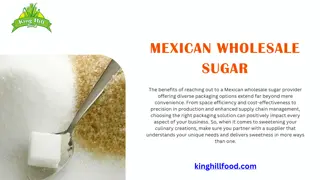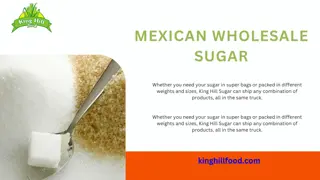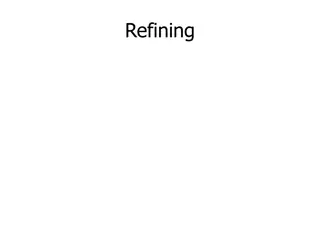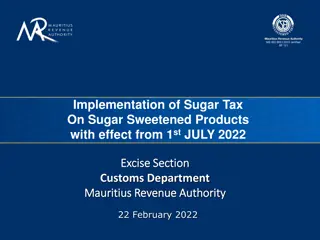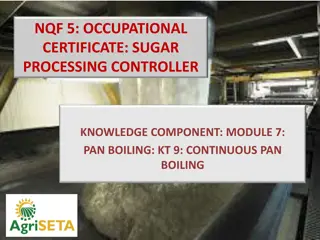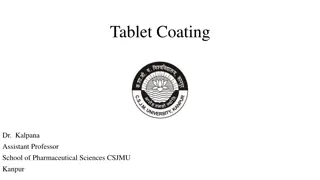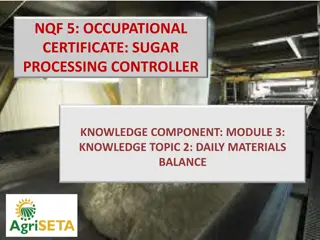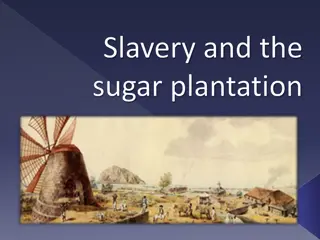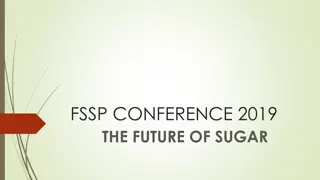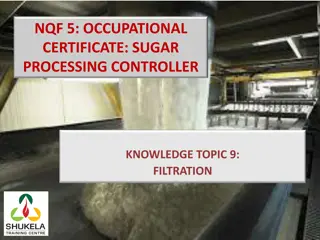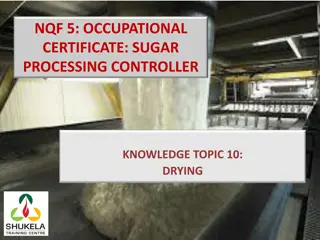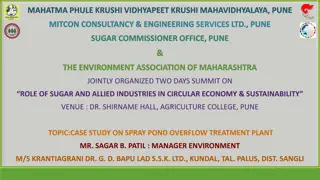Sugar Processing: Bagasse Utilization Overview
Bagasse, the residue from sugarcane crushing, serves as a valuable resource for biofuel production and more. Explore its composition, storage methods, and use as a fuel source in sugar mills for energy generation. Learn about its chemical makeup and potential for cogeneration, contributing to sustainable practices in the sugar industry.
Uploaded on Mar 08, 2025 | 0 Views
Download Presentation

Please find below an Image/Link to download the presentation.
The content on the website is provided AS IS for your information and personal use only. It may not be sold, licensed, or shared on other websites without obtaining consent from the author.If you encounter any issues during the download, it is possible that the publisher has removed the file from their server.
You are allowed to download the files provided on this website for personal or commercial use, subject to the condition that they are used lawfully. All files are the property of their respective owners.
The content on the website is provided AS IS for your information and personal use only. It may not be sold, licensed, or shared on other websites without obtaining consent from the author.
E N D
Presentation Transcript
NQF 5: OCCUPATIONAL CERTIFICATE: SUGAR PROCESSING CONTROLLER KNOWLEDGE COMPONENT: MODULE 4: SUGAR JUICE EXTRACTION: KT8: BAGASSE HANDLING
What is Bagasse? Bagasse is the dry pulpy fibrous residue that remains after sugarcane is crushed to extract its juice. It is used as: biofuel for the production of heat, energy, and electricity, and in the manufacture of pulp and building materials
Production For every 10 tons of sugarcane crushed, a sugar factory produces nearly three tons of wet bagasse. Since bagasse is a by-product of the cane sugar industry, the quantity of production in each country is in line with the quantity of sugarcane produced. The high moisture content of bagasse, typically 40 50 percent, is detrimental to its use as a fuel.
Storage In general, bagasse is stored prior to further processing. For electricity production, it is stored under moist conditions, and the mild exothermic process that results from the degradation of residual sugars dries the bagasse pile slightly. For paper and pulp production, it is normally stored wet in order to assist in removal of the short pith fibres, which impede the paper making process, as well as to remove any remaining sugar.
Bagasse Composition A typical chemical analysis of washed and dried bagasse might show: Cellulose 45 55 percent Hemicellulose 20 25 percent Lignin 18 24 percent Ash 1 4 percent Waxes <1 percent Bagasse is a heterogeneous material containing around 30 - 40 percent of "pith" fibre, which is derived from the core of the plant and is mainly parenchyma material, and "bast", "rind", or "stem" fibre, which makes up the balance and is largely derived from sclerenchyma material. These properties make bagasse particularly problematic for paper manufacture and have been the subject of a large body of literature.
Bagasse as Fuel Many research efforts have explored using bagasse as a biofuel in renewable power generation and in the production of bio-based materials. Bagasse is often used as a primary fuel source for sugar mills. When burned in quantity, it produces sufficient heat energy to supply all the needs of a typical sugar mill, with energy to spare. To this end, a secondary use for this waste product is in cogeneration, the use of a fuel source to provide both heat energy, used in the mill, and electricity, which is typically sold on to the consumer electrical grid.
Bagasse as Fuel (cont.) The lower calorific value (LCV) of bagasse in kJ/kg may be estimated using the formula: LCV = 18260, where the moisture, brix and ash content of the bagasse are expressed as a percentage by mass. Similarly, the higher calorific value (HCV) of bagasse may be estimated using: HCV = 19605 - 196.05 Moisture - 31.14 Brix - 196.05 Ash.
Bagasse as Fuel (cont.) The resulting CO2 emissions are less than the amount of CO2 that the sugarcane plant absorbed from the atmosphere during its growing phase, which makes the process of cogeneration greenhouse-gas-neutral. In countries such as Australia, sugar factories contribute "green" power to the electricity grid. Hawaiian Electric Industries also burns bagasse for cogeneration. Ethanol produced from the sugar in sugarcane is a popular fuel in Brazil.
Bagasse as Fuel (cont.) The cellulose-rich bagasse is being widely investigated for its potential for producing commercial quantities of cellulosic ethanol. For example, until May 2015 BP was operating a cellulosic ethanol demonstration plant based on cellulosic materials in Jennings, Louisiana. Bagasse's potential for advanced biofuels has been shown by several researchers. However, the compatibility with conventional fuels and suitability of these crude fuels in conventional engines have yet to be proven.
Other uses As a substitute for wood Bagasse is commonly used as a substitute for wood in many tropical and subtropical countries for the production of pulp, paper and board, such as India, China, Colombia, Iran, Thailand, and Argentina. It produces pulp with physical properties that are well suited for generic printing and writing papers as well as tissue products but it is also widely used for boxes and newspaper production. It can also be used for making boards resembling plywood or particle board, called bagasse board and Xanita board, and is considered a good substitute for plywood. It has wide usage for making partitions and furniture.
Other uses (cont.) As a substitute for wood (cont.) The industrial process to convert bagasse into paper was developed in 1937 in a small laboratory in Hacienda Paramonga, a sugar mill on the coast of Peru owned by W.R. Grace Company. With a promising method, the company bought an old paper mill in Whippany, New Jersey and shipped bagasse from Peru to test the viability of the process on an industrial scale. The first paper manufacturing machines were designed in Germany and installed in the Cartavio sugar cane plant in 1938. Sociedad Paramonga was bought in 1997 by Quimpac and in 2015 produced 90,000 metric tons of office paper, toilet paper and cardboard for the Peruvian market.
Other uses (cont.) As Animal Feed K-Much Industry has patented a method of converting bagasse into cattle feed by mixing it with molasses and enzymes (such as bromelain) and fermenting it. It is marketed in Thailand, Japan, Malaysia, Korea, Taiwan and Middle East and Australia. Several companies in South Africa use bagasse with added molasses as animal feed.
Other uses (cont.) Nanocellulose Nanocellulose can be produced from bagasse through various conventional and novel processes. This provides a pathway to generate higher- value products from what can be considered a process waste stream.





